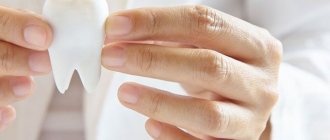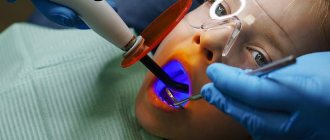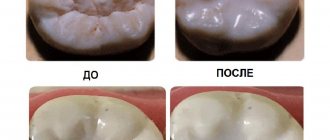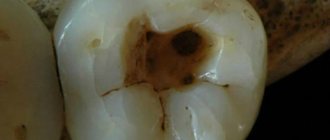Fissure caries is a lesion of the hard tissues of the tooth, localized in the natural recesses of the chewing group of teeth. The risk group includes children with temporary dentition, people with poor hygiene, as well as those with teeth with complex fissure anatomy. Unfortunately, patients often do not notice the pathology and do not consult a doctor. This leads to an aggravation of the process and possible complications (pulpitis, periodontitis, tooth loss). It is important to identify the process in a timely manner, identify it and begin treatment immediately.
Make an appointment with a therapist by phone+7(985)532-21-01
Anatomy of fissures of the chewing group of teeth
Fissures are anatomical depressions and grooves between the cusps on the chewing surface of the crowns of the lateral teeth (premolars and molars). They provide food chopping and grinding. Depending on their structure, fissures are divided into four types:
- Cone-shaped;
- Grooved;
- Teardrop-shaped.
The deeper and narrower their shape, the greater the likelihood of developing cariogenic microflora. Food particles remain in natural cavities even after thorough brushing. This contributes to the active spread of the pathological process.
Fissure caries clinic
The carious process begins secretly and painlessly. Most patients do not attach importance to discoloration in the area of natural recesses of molars and premolars, due to which the pathology intensively develops and spreads to the deeper tissues of the tooth. The main symptoms of fissure caries:
- Changing the natural color of teeth. Due to destruction (destruction) and the activity of microorganisms, dental tissues darken. The fissures become dark brown and clearly visible;
- Hyperesthesia (increased tooth sensitivity). The tooth reacts to temperature and taste stimuli, the patient complains of pain, which goes away when the triggers are eliminated;
- Independent pain syndrome that does not stop after eliminating irritating factors. The pathological process spreads to the dental pulp, which consists of nerve fibers and blood vessels; patients note the nocturnal nature of the attacks. If the pain continues to intensify, caries develops into acute pulpitis.
Indications and contraindications
Since every person has fissures, their sealing can be recommended for all patients. As mentioned earlier, most often such preventive measures are prescribed in childhood. This is due to the fact that the milk and newly emerged radical units are very weak and not resistant to the aggressive effects of bacteria. The enamel of such teeth still lacks the minerals that are necessary to protect against caries.
For patients over 20 years of age, sealing may be recommended for deep and very narrow grooves. They are almost impossible to clean well during daily hygiene procedures.
Unfortunately, like any treatment, this technique has some contraindications. Sealing is not carried out when caries or pulpitis is detected, when a unit has partially erupted above the gum tissue, as well as when the unsatisfactory general condition of the teeth and gums is diagnosed due to a lack of daily hygiene procedures.
previous post
What to do if a dental implant is loose?
next entry
Methods for studying fissure caries
Correct and timely diagnosis of caries is the key to successful treatment of the patient. It includes:
- Visual examination of the oral cavity. Allows you to identify the presence of a carious process in shallow fissures;
- Probing. Using a metal instrument, the dentist examines the density of tooth tissue. The affected tissues have a loose consistency, they retain the probe, it seems to “fall through”;
- Percussion. Using the blunt end of the instrument, the dentist checks for the presence of pain and the involvement of periodontal tissue in the process.
Additional methods for diagnosing fissure caries
- X-ray examination makes it possible to identify foci of destruction of enamel and dentin in the images, as well as to detect the spread of the process even at the initial stages;
- Using the transillumination method, the dentist can see the affected tissue without preparing the tooth. In bright light, the carious process has a brown color;
- Fissurotomy is an option for diagnosing pathology. A diamond bur is used to grind the affected enamel down to the border of healthy tissue. This method is minimally invasive and allows you to assess the extent of caries spread.
Clinical researches
The active components of the complex help reduce bleeding and inflammation in the oral cavity.
- A unique complex of vitamins, microelements and plant extracts, specially selected to maintain the health of the oral cavity and the body as a whole.
- Coral calcium and coenzyme Q10 in the composition strengthen gums and tooth enamel.
- Vitamins support general immunity.
At the Department of Therapeutic Dentistry of St. Petersburg State Medical University named after. acad. I.P. Pavlova, it was proven that the joint use of Asepta dental line products makes it possible to achieve a complex effect. Taking into account the active components that make up these Asepta products, their clinical properties and the effect they have on the soft tissues of periodontium, they can be used both as independent agents in the initial stages of diseases, and in combination with medications for severe forms of chronic periodontal diseases.
Considering the therapeutic and prophylactic properties of the Asepta line, they can be used for inflammatory diseases of the oral mucosa, such as catarrhal stomatitis, glossitis and cheilitis.
Sources:
- The use of new anti-inflammatory drugs in the complex of therapeutic and preventive measures for periodontal diseases (E.D. Kuchumova, A.A. Leontyev, O.V. Kalinina, L.Yu. Orekhova, S.B. Ulitovsky) E.D. Kuchumova, Ph.D., Associate Professor, A.A. Leontyev, dentist, O.V. Kalinina, dentist, L.Yu. Orekhova, Doctor of Medical Sciences, Professor, Head of Department, S.B. Ulitovsky, Doctor of Medical Sciences, Prof. Department of Therapeutic Dentistry of St. Petersburg State Medical University named after. acad. I.P. Pavlova
- The use of drugs from the Asepta line in the complex treatment of inflammatory periodontal diseases (N.V. Berezina E.N. Silantyeva S.M. Krivonos, Kazan State Medical Academy. Kazan.) N.V. BEREZINA, E.N. SILANTIEVA, S.M. KRIVONOS Kazan State Medical Academy
- The role of anti-inflammatory rinse in the treatment of periodontal diseases (L.Yu. Orekhova, A.A. Leontyev, S.B. Ulitovsky) L.Yu. OREKHOVA, Doctor of Medical Sciences, Prof., Head of Department; A.A. LEONTIEV, dentist; S.B. ULITOVSKY, Doctor of Medical Sciences, Prof. Department of Therapeutic Dentistry of St. Petersburg State Medical University named after. acad. I. P. Pavlova
How to treat fissure caries
The basic principle in the treatment of fissure caries is the complete removal of necrotic tissue. The following stages of treatment can be distinguished:
- Opening a carious cavity with a spherical bur, removing affected enamel and dentin, creating an area for a future filling;
- Total etching with phosphoric acid to destroy pathogenic microflora;
- Drying with chlorhexidine or alcohol solution;
- Adhesive protocol, application of bonds to improve the adhesion of the composite to dentin tissues;
- Crown restoration using light-curing composite materials. The materials are illuminated with ultraviolet lamps;
- Checking occlusal contacts (correct closure of teeth), grinding and polishing the filling with special cutters and rubber attachments.
Treatment method without preparation
If caries has not yet spread to the dentin and is limited to the enamel, the dentist can offer the patient a treatment option without preparation:
- Icon technique: after etching the tooth tissue, a special infiltrate is applied to the crown. It is sealed with a transparent composite and illuminated with a lamp;
- Laser therapy: the affected areas are destroyed under the influence of radiation. Despite the fact that the equipment for this type of diagnostics is expensive, private clinics widely use it in their practice; You can learn more about laser caries treatment.
- Ozonation: acting on cariogenic microorganisms, ozone kills them and creates a protective barrier on the tooth surface.
- Using the drug Innodent Repair. Restoration of enamel and treatment of caries in the early stages of the disease.
Make an appointment with a therapist by phone+7(985)532-21-01
Fissurotomy
The difference between fissurotomy and the previous method is that before sealing, the condition of the fissure is diagnosed using a sharp probe, during which narrow, deep grooves and fissures are opened or widened. In order to detect caries in dental tissue, laser diagnostics and the vital staining method are also used.
In order to expose suspicious fissures, a diamond or carbide bur is used. If during the preventive removal of the fissure enamel layer no signs of caries are detected, sealing is carried out using low-viscosity composite materials or glass ionomer cements.
Fissure caries in children
Caries is a common pathology among children. The tissues of baby teeth are not sufficiently mineralized, which is why there are spaces in the enamel where pathogenic microflora can easily penetrate. Poor hygiene contributes to the spread of the process to neighboring areas of the dentition. Lower permanent molars are more often exposed to cariogenic processes than other teeth.
They have a complex anatomy, are the first to erupt in the bite, and do not have a maxillary pair. Despite the fact that baby teeth fall out over time, their treatment must be approached seriously and responsibly. Parents are recommended to bring their child for a dental examination once every six months, teach him how to brush his teeth correctly, using not only toothpaste, but also mouthwash, and monitor oral hygiene.
Invasive and non-invasive sealing
Sealing can be carried out using two different methods: invasive and non-invasive. The first is used in cases where the condition of the furrows cannot be assessed by visual inspection. This may be due to their great depth or their special, closed structure. This technology involves several stages. At the first stage, the dentist must carry out professional cleaning of the oral cavity, during which he removes plaque and other hard deposits from the enamel. Next, he proceeds to carefully prepare and open the fissures using special tools.
Next comes the stage of thoroughly drying and insulating the desired area. After this, the tissues are treated with special means, for example, orthophosphoric acid (32% solution); filling material is placed into the resulting cavity. The sealant hardens under the influence of an ultraviolet lamp. After all manipulations, the surface must be ground and polished. Treatment is carried out under local anesthesia; in rare cases, general anesthesia may be prescribed.
Non-invasive technology is recommended for teeth with open fissures. In this case, there is no need for preparation, the grooves are simply filled with a sealing substance, and the tooth surface is leveled. The sequence of actions is exactly the same as for an invasive procedure.
Prevention of fissure caries
Prevention of fissure caries is the key to successful treatment and avoidance of relapses. The following preventive measures are distinguished:
- Fissure sealing is the most effective method to date and almost completely eliminates the possibility of recurrence of caries. It is widely used among pediatric patients, is easy to perform and painless. After preparing the tooth for the procedure, it is treated with a flowable transparent composite or glass ionomer cement. The purpose of sealing is to prevent microbes from accessing the fissures.
- The stronger the enamel, the more prismatic elements it contains and the fewer free spaces. Remineralization therapy is indicated for patients with fragile enamel. The surface of the tooth crown is treated with fluoride varnishes, preparations with a high calcium content.
Features of the procedure
Absolutely every person's teeth numbered 6, 7 and 8 on both jaws have special grooves. Quite often food particles get into them, which leads to the active proliferation of bacteria. As a result of their vital activity, acids are produced, which gradually destroy tooth enamel and lead to the formation of caries.
This pathology is the most common in both children and adults; it is diagnosed in 99% of the population. What is fissure sealing? This is the sealing of a surface to protect it from dirt and germs. For this purpose, a special filling compound is used. As a result of this treatment, the tooth becomes stronger and more resistant to the destructive effects of pathogens.
Sealing is prescribed by a doctor only on the basis of the diagnosis and if there are serious indications for this procedure. It is very important to study the structure, depth and location of the grooves and only after that make a final decision on the need to apply filling material.
Prevention of fissure caries at home
It is important to observe prevention not only at dental appointments, but also at home. Oral hygiene is a complex procedure. It includes:
- Individual cleaning with a medium-hard brush. The necessary components of toothpaste are active calcium (ROCS, Colgate, etc.) and fluoride (President Classis, Splat, etc.);
- Using dental floss to clean the interdental spaces;
- For more thorough hygiene, it is recommended to use an irrigator;
- After traditional brushing, do not forget to rinse your mouth with sodium fluoride solutions. The optimal fluorine concentration in the solution is 250 ppm.
The prognosis for fissure caries is favorable. Thanks to planned treatment, oral sanitation and good hygiene, relapse can be prevented and complications can be avoided. To improve the condition of your teeth, you need to take care of them, as well as adhere to a balanced diet and exclude carbohydrates from your diet. Remember: healthy teeth are the guarantee of a snow-white smile.
Make an appointment with a therapist by phone+7(985)532-21-01
Do fissure dental caries need to be treated?
Removal of a wisdom tooth cyst
Caries in the white spot stage
Tooth granuloma, what is this disease and how to cure it
Treatment of wisdom tooth caries if it hurts
Treatment of dental cyst without removal
Treatment of average dental caries from 6,000 rubles - sign up at the clinic of the Central Administrative District of Moscow
Cost of treating a wedge-shaped defect
| Superficial caries | 2 200 ₽ |
| Average caries | 3 800 ₽ |
| Deep caries | 4 600 ₽ |
| Relief of acute pain (anesthesia, medicinal treatment of canals, application of medications, temporary filling) | from 3,100 ₽ |
| Temporary filling | 300 ₽ |
| Treatment of cervical caries | 3 200 ₽ |
Make an appointment
Stages of the disease
There are several stages in the course of a wedge-shaped defect:
- Initial. The depression is almost impossible to see with the naked eye; damage to the enamel can only be diagnosed by a dentist.
- Superficial. The defect is revealed in the form of a superficial groove 2-3 mm long; the tooth can react to external stimuli.
- Average. The notch becomes deeper, its length increases to 4-4.5 mm, the walls of the defect are visually determined, which converge with each other in the form of the letter V.
- Deep. The wedge-shaped defect is clearly visible, the length of which is 5 mm or more. In depth, the lesion reaches the deep layers of dentin, in severe cases it reaches the pulp chamber.
The first two stages are usually diagnosed in young patients. Medium and deep degrees of damage are more typical for mature people who have crossed the 40-45 year mark.
It is noteworthy that during the course of the disease there are 2 phases - rapid and stable. In the fast phase, tissue loss occurs at a high speed (in 2-3 months), and tooth hypersensitivity develops. In the stabilization phase, the development of the disease slows down, hyperesthesia decreases or disappears altogether.











